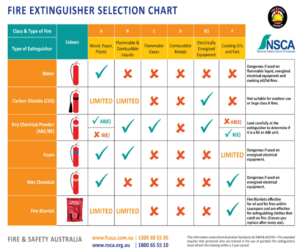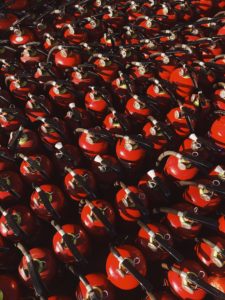Fires can be helpful. But at the same time, uncontrolled and accidental fires can be dangerous. With this powerful double-edged sword, humanity has found ways to extinguish fires and prevent further damage. (1)
We have come a long way from the discovery of fire by our ancient ancestors to a deep and scientific understanding of fires and its factors. Nowadays, various methods and substances are used to put out certain types of fires. (2)
Fire can be classified according to the agent that fuels them into 5 different categories. Certain types of fires is better dealt with using certain types of extinguishing agents, whereas other types can actually make it worse. For example, spraying water on a Class B or Class C fire can actually feed it instead of putting it out. (2)
The image below is known as a fire extinguisher chart, which summarizes this information easily.

Image source: https://www.fireandsafetyaustralia.com.au/product/free-fire-extinguisher-safety-chart/
The use of fire-preventing technology is also slowly becoming a standard for most commercialized buildings. Whenever there is a fire hazard, fire extinguishers and water mists are also placed. Technology has also built on the basic principles found out by science in order to invent new anti-fire devices. (3)
Also, it is worth noting that the main function of fire departments is fire prevention, and not extinguishing. Fire prevention is the practice of educating the public on how to take precautionary methods to avoid otherwise harmful fires. (4)
Despite all of this preparation and advancement against fire, we are still losing lives and losing our livelihood. Even if technology has improved, fire remains as an enemy of mankind.

This is because unlike what the ancient Greeks thought of in the past, fire is not “matter”, like how a solid rock is. You simply cannot move it from one place to another. It is a chemical process and is fueled by factors that when present together in the right place and right time, can present themselves into a very dangerous situation. (1)
Moreover, the focus seems to be more on fire prevention, rather than fire extinguishing. While promoting fire prevention is extremely beneficial, we should not only focus on it. It takes away from the real danger when a fire is already swallowing up your home and family, WHAT SHOULD YOU REALLY DO?
We focus more on prevention, but when we are confronted by the real danger of flames, we suddenly don’t know what to do but rely on the authorities.
In order to find a solution to the problem, we must first identify the critical factors that make current fire extinguishing methods not 100% effective and reliable.
Here is a list of 5 of them.
1. Water has a lot of limitations as a fire extinguisher
The common knowledge is to combat any type of fire with water. However, contrary to common belief, water has a lot of limitations as a fire-extinguishing agent. (5)
First, water is a great conductor of electricity. Blasting water on fires that occur in highly electrical settings might risk making the situation far worse. (5)
Second, water cannot be used on certain types of fires, such as grease fires and chemical fires. Some chemicals, such as lime, can spontaneously heat up in certain situations. (5)
Water alone, without any additives, is considered to have the low fire-extinguishing capacity and can only put out small fires. Water can rapidly slide on certain surfaces and cause a blanket to form around such surfaces, making it more difficult to put out the fire. (5)
2. Fire extinguishers are limited, too
 As mentioned earlier, only certain types of fire extinguishers can put out certain fires. If you match the wrong fire extinguisher to the wrong kind of fire, it might end badly. (6)
As mentioned earlier, only certain types of fire extinguishers can put out certain fires. If you match the wrong fire extinguisher to the wrong kind of fire, it might end badly. (6)
That being said, there is not much one “universal” fire extinguisher that can easily extinguish all types of fire. (6)
Most fire extinguishers also have some sort of kickback or disadvantage. Take dry powder extinguishers for example, while it can put out most fires, it isn’t suitable for fires surrounded by combustible materials and oil/grease-based ones. Moreover, it has a lot of collateral damage and offers little to no cooling effect, and easily increases the risk of re-igniting the fire you just put out. (6)
Additionally, it is highly discouraged for someone who has no knowledge of using a fire extinguisher to use it to put out fires, as they may just risk spreading or fanning it out. (7)
3. The three main ways of putting out fires are restrictive and small-scale
A fire triangle refers to a diagram that shows the three components needed for the occurrence of fire: heat, oxygen, and fuel (combustible materials). The three main ways of putting out fires rely on the principle of taking away one of these components. (8)
Starvation is removing the fuel from the system (the material that is catching on fire). Cooling is to remove the heat from the system and lastly, smothering is to cut off the fire’s oxygen supply. (7)
These three methods, in isolation, only are effective for small-scale fires. Take starvation of fire as an example — it works by removing the fuel. Removing the fuel is only possible for small-scale fires. What if it’s a house that is feeding the fire? Would it be possible to remove the house, then? (9)
Cooling, on the other hand, is the reduction of temperature within the system. In which case, water is almost always commonly used. Such disadvantages of water as a fire extinguisher are already discussed in the first subtext of this article. (9)
Most fire emergencies require multiple steps and a combination of these three common methods for successful extinguishing. That is a lot of effort and a lot of time that we are risking, instead of quickly fixing the disaster.
4. Fire departments are not always reliable
In the case that the fire has become unmanageable, people will opt to call 911. While the main objective of the fire department and firefighters is to ensure the safety of the public, let us face the truth: fire departments are not always reliable.
This is mostly the case for underdeveloped countries and towns that are far away from the city centers.
In a country such as the Philippines, the fire department is not always efficient due to factors they cannot control: traffic, narrow alleys that are impossible to get to, and lack of firefighters and fire trucks. (10)
These factors all affect the speed at which firefighters can respond to the scene and the efficiency of how fast they can extinguish the fire. (10)
Such situations should be studied and provided solutions by the government. However, as of now, such improvement seems to be far away for these countries.
5. Certain substances are not always available
Fire first aids include sprinkling dry and powdery substances to small fires. These may include sodium bicarbonate (baking soda), salt or sand, to the fire. (11)
However, you would need large amounts of this stuff in order to smother the fire completely. And not all households have a huge box of baking soda or salt lying around. In the case of sand, it presents the problem of fires starting in apartment complexes, dozens of floors from the ground, with no easy access to the sand.
How then, should the people put out the small kitchen fire in their homes?
The pre-existing methods of extinguishing fires present limitations and problems. At present, most have disadvantages that easily put lives in danger.
Such outdated technology should be left in the past, as an all-around fire extinguishing device is coming to town.
Find out more about this fire extinguisher in our other articles.
Sources:
- https://science.howstuffworks.com/environmental/earth/geophysics/fire.htm
- https://www.google.com.ph/amp/s/amp.insider.com/types-of-fires-and-how-to-put-them-out-2018-12
- http://www.strikefirstusa.com/2016/08/7-remarkable-new-fire-safety-technologies/
- https://www.hsa.ie/eng/Topics/Fire/Fire_Prevention/
- http://www.ecuatepi.com/english/news-offers-technical-ecuadorian-of-protection-against-fire-security-industrial-extinguishers-fire-latin-american-ecuador.php?tablajb=noticias&p=10&t=Limitations-on-the-use-of-water-as-an-extinguishing-agent&#
- https://support.brandbeveiligingshop.be/hc/en-be/articles/115002061729-What-are-the-advantages-and-disadvantages-of-certain-types-of-fire-extinguishers-
- https://m.wikihow.com/Extinguish-a-Fire-at-the-Initial-Stages
- https://www.elitefire.co.uk/help-advice/fire-extinction-methods-approaches/
- http://www.nzdl.org/gsdlmod?e=d-00000-00—off-0aedl–00-0—-0-10-0—0—0direct-10—4——-0-1l–11-en-50—20-about—00-0-1-00-0–4—-0-0-11-10-0utfZz-8-10&cl=CL1.1&d=HASH01df7e8d840f67b4d60dc01b.19.3.4>=1
- https://www.google.com.ph/amp/s/amp.rappler.com/nation/206228-bureau-fire-protection-shortage-firefighters-trucks-audit-report-2017
- https://www.britannica.com/science/sodium-bicarbonate